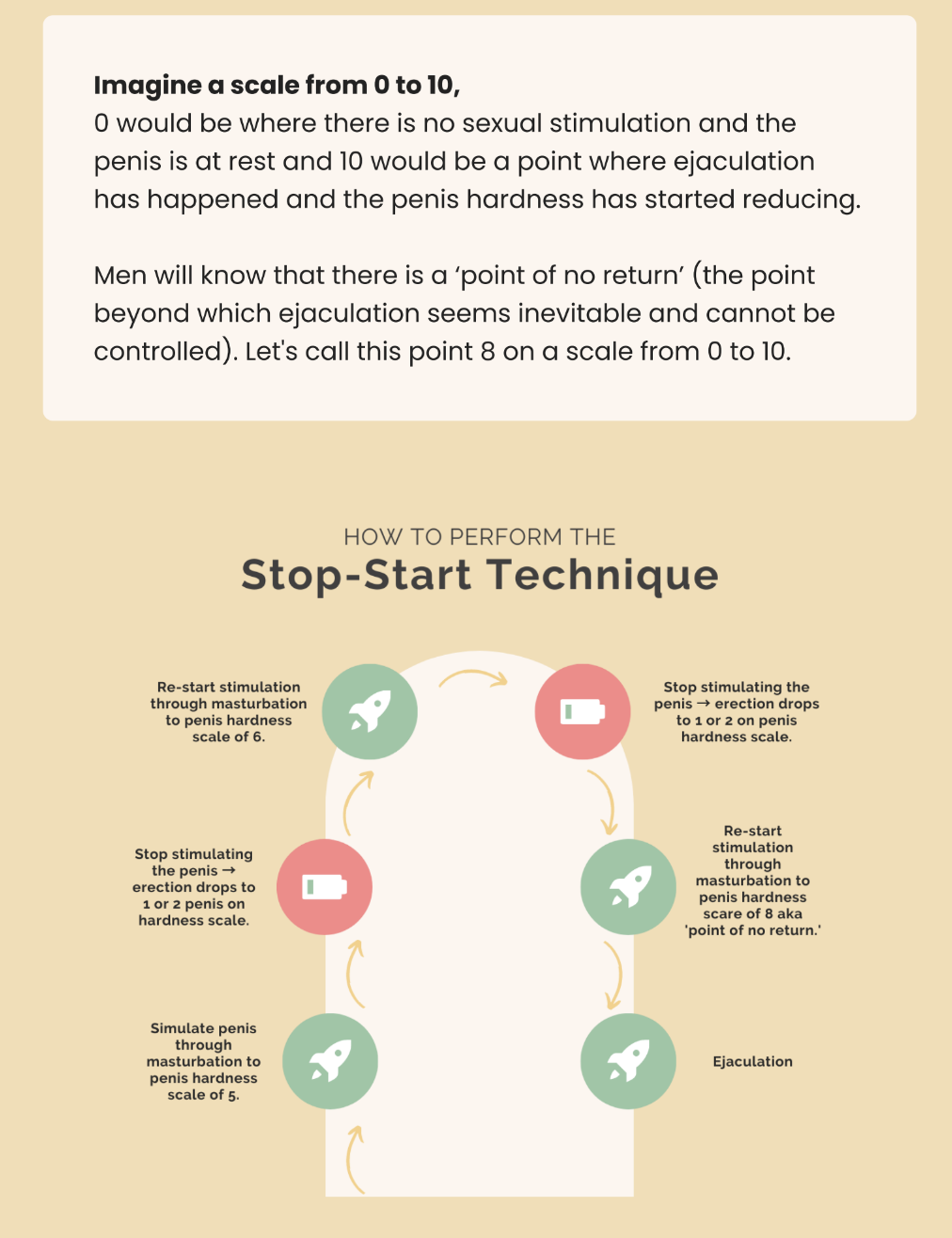Start Stop Technique For Premature Ejaculation

Allo Health is dedicated to personalized well-being, offering support and trusted information tailored to individual health goals. The platform emphasizes human-generated content, led by a distinguished medical team of experts, including physicians and sexual health specialists. Their commitment to credibility involves rigorous fact-checking, authoritative research, and continuous updates to ensure accurate, up-to-date information. Allo Health's unique approach goes beyond conventional platforms, providing expert-led insights and a continuous commitment to excellence, with user feedback playing a crucial role in shaping the platform's authoritative voice.

A Psychotherapist with Clinical specialization, working for over seven years now. Areas of specialization range from Anxiety-related disorders, Mood-related disorders, Personality disorders, Sexual dysfunctions & other mental health issues.
Why This Was Upated?
Our experts continually monitor the health and wellness space, and we update our articles when new information became available.
Updated on 11 June, 2024
- Article was updated as part of our commitment to diversity, equity, and inclusion.

"The following blog article may discuss medical treatments and interventions. However, it is important to note that the information provided is for general educational purposes only and should not be considered as a substitute for professional medical advice, diagnosis, or treatment. Always seek the guidance of a qualified healthcare professional for personalized medical advice.
Book consultation
Medical treatments are complex and should be tailored to individual circumstances. The information presented in this blog may not be applicable to everyone, as each person's medical condition, history, and needs are unique. Only a qualified healthcare professional can evaluate your specific medical situation, consider relevant factors, and provide appropriate recommendations for diagnosis, treatment options, and monitoring.
It is crucial to note that self-diagnosis, self-medication, or relying solely on the information provided in this blog for treatment decisions can have serious health consequences. "
The Start-Stop Technique is a behavioral therapy technique commonly used to help individuals with premature ejaculation (PE). Premature ejaculation is not a disease, it is a sexual dysfunction that is highlighted by the inability to control ejaculation. It is considered a common condition and is not typically associated with any underlying diseases.
The Start Stop Technique for premature ejaculation can help individuals by improving their control over ejaculation and extending the duration of sexual activity. It involves the individual or their partner stimulating the penis until they are about to reach the point of ejaculation, at which point stimulation is paused. This pause allows the individual to regain control and prevent premature ejaculation. The process is advised to be repeated several times, gradually increasing the duration of sexual activity before ejaculation.
The start stop Technique is primarily used for addressing premature ejaculation and is not intended to treat or manage other diseases or conditions. Individuals should consult with a healthcare professional who can provide personalized advice based on your circumstances.
Start Stop Technique For Premature Ejaculation
The start stop technique, also known as the start-stop technique or the stop-and-start method, is a behavioral strategy is used to delay ejaculation and extend sexual activity. It is commonly employed as a form of self-help or behavioral therapy for individuals who experience premature ejaculation.
Here’s a detailed explanation of the stop-start technique and how it is typically practiced:
- Preparation: Both partners should engage in open communication and be willing to actively participate in the technique. It is important to create a relaxed and comfortable environment, free from distractions or performance anxiety.
- Sexual Stimulation: Begin sexual activity, such as foreplay or intercourse, as usual. The goal is to engage in activities that lead to sexual arousal.
- Stop at the Right Time: When the person feels that ejaculation is imminent or they are reaching the point of no return (the stage where ejaculation cannot be stopped), they or their partner should signal to stop all sexual stimulation. This can be achieved through a verbal cue or a physical gesture.
- Pause and Relaxation: Once stimulation has ceased, the person should take a break and focus on relaxation techniques to reduce arousal levels. This can involve deep breathing exercises, distraction techniques (thinking about non-sexual topics), or using relaxation techniques such as progressive muscle relaxation.
- Resuming Sexual Stimulation: After the person feels that their arousal has decreased and they are no longer on the verge of ejaculation, sexual activity can be resumed. This can start with gentle and non-stimulating activities and gradually progress to more intense stimulation.
- Repeat as Needed: The process of sexual stimulation, stopping, and restarting can be repeated as many times as necessary to prolong the sexual experience and delay ejaculation. The goal is to gradually increase the duration of sexual activity before ejaculation occurs.
- Final Completion: When both partners are ready to conclude the sexual activity, they can proceed to allow ejaculation to happen.
The start stop technique for premature ejaculation aims to help individuals gain better control over their arousal levels and delay ejaculation by learning to recognize and manage the point of no return. With practice, individuals can gradually increase their control and prolong sexual activity before reaching orgasm.
It is worth noting that the start stop technique for premature ejaculation requires patience, practice, and active participation from both partners. It is also helpful to combine this technique with other approaches, such as communication, exploring different sexual positions, and using additional techniques or treatments that address premature ejaculation, if necessary.
– You need to start to stimulate (through masturbation) the penis until you get to a 5 on the scale, at this point, you stop stimulating.
This may lead to the erection dropping down, when it gets to a 1 or 2, start stimulating again and this time get it to a 6 on the imaginary scale and allow it to drop down again. Start the stimulation and repeat it once or twice more before allowing yourself to cross the point of no return (8) and ejaculate.
– Doing this exercise by yourself over a couple of weeks should give you an idea about your threshold for ejaculation.
– This knowledge can then be transferred to sexual intercourse with your partner or during mutual masturbation with them. You can guide your partner into how the stimulation should be and at what point should they slow down so that you can delay the ejaculation time.
Key Takeaways
- The start-stop technique involves stimulation of the penis just before you orgasm, and then pausing till you feel the urge to ejaculate diminish. This, when repeated and practiced several times allows you to better understand and identify your sexual arousal levels just before you orgasm. You then learn how to control and delay your ejaculation.
- The start-stop method, a type of behavioural techniques (and effective) is commonly implemented alongside pharmacological treatment or medical management such as Phosphodiesterase-5 inhibitors (PDE-5) or selective serotonin reuptake inhibitors (SSRIs) anaesthetic creams (numbing creams), and/or analgesic effects. All treatments help in gaining better ejaculation control.
- During sexual activity, you shouldn’t keep a time goal or time limit in mind. Behavioural-based treatment alongside exercises such as this will help in pelvic floor muscles rehabilitation and in understanding levels of stimulation. Performance anxiety is common is those that experience PE symptoms, and exercises such as these will help you gain confidence in the bedroom.
- Ejaculatory Dysfunction is common, and while it may seem daunting to explore your sexual pleasures, we encourage you to be open-minded and seek the right help.
- Premature Ejaculation treatments are based on the cause behind your symptoms, an holistic evaluation is imperative.
Frequently Asked Questions
(1) How does the stop-start technique for premature ejaculation work?
The stop-start technique works by interrupting sexual stimulation when ejaculation is imminent or the person reaches the point of no return. By taking a break from stimulation and practicing relaxation techniques, arousal levels decrease, allowing individuals to gain better control over their ejaculation response. This technique helps to delay ejaculation and extend sexual activity.
(2) Can the stop-start technique be used by individuals with erectile dysfunction?
Yes, the stop-start technique can be used by individuals with erectile dysfunction. While the technique focuses on delaying ejaculation, it can also help in managing erectile dysfunction. By practicing the stop-start technique, individuals can reduce anxiety and pressure related to maintaining an erection, while also increasing their overall sexual confidence and enjoyment.
(3) How long does it take to see results with the stop-start technique for premature ejaculation?
The time it takes to see results with the stop-start technique can vary from person to person. Some individuals may notice improvements in their ejaculation control relatively quickly, while others may require more time and practice. Consistent practice, open communication with a partner, and patience are key to achieving desired results. Progress can vary, and it can take several weeks or even months to achieve significant improvements.
(4) Can the start stop technique for premature ejaculation be used as the sole treatment?
The stop-start technique can be helpful as a self-help technique or as part of a comprehensive treatment approach for premature ejaculation. However, it may not be sufficient as the sole treatment for individuals with persistent or severe premature ejaculation. Combining the stop-start technique with other strategies such as behavioral therapy, counseling, or medical interventions (if necessary) can enhance its effectiveness and provide more comprehensive management of premature ejaculation.
(5) Is the start and stop technique for premature ejaculation effective for everyone?
The effectiveness of the stop-start technique can vary from person to person. While many individuals find it helpful in delaying ejaculation and extending sexual activity, it may not work equally well for everyone. Physiology, psychological factors, and the underlying causes of premature ejaculation can influence the effectiveness of the technique. It is important to remember that if the stop-start technique does not provide satisfactory results, seeking guidance from a healthcare professional or a qualified sex therapist is advisable to explore other treatment options tailored to individual needs.
(6) Do I wear condoms when practicing the stop-start technique for premature ejaculation?
The decision of whether or not to wear condoms while practicing the stop-start technique is a personal one and can depend on various factors.
Protection against STIs and pregnancy: If you and your partner are not in a mutually monogamous relationship or if you are not using other forms of contraception, wearing condoms protects against sexually transmitted infections (STIs) and unintended pregnancy. Condoms provide a barrier that can help reduce the risk of transmission of STIs and act as a form of contraception.
Sensation and arousal levels: Some individuals find that wearing a condom can reduce sensation and arousal levels, potentially helping to prolong sexual activity. The decrease in sensation may make it easier to practice the stop-start technique and delay ejaculation. On the other hand, some individuals may find that condoms reduce sensitivity too much, making it more challenging to maintain an erection or achieve orgasm.
Personal preferences: Personal preferences and comfort play a significant role. Some individuals may prefer the feeling of skin-to-skin contact and find that condoms interrupt the natural sensations of sexual activity. Others may feel more at ease and relaxed knowing they are using condoms for protection.
Ultimately, the decision should be made based on your specific circumstances and preferences. It may be helpful to discuss this with your partner and consider factors such as your STI status, contraceptive needs, and individual sensations and preferences.
If you choose to use condoms while practicing the stop-start technique, it is important to select the correct size and ensure they are properly fitted to maximize comfort and effectiveness. Additionally, using lubrication with condoms can enhance comfort and reduce friction during sexual activity.
Remember, if you have concerns or questions about contraception or STI prevention, it is advisable to consult with a healthcare professional who can provide personalized guidance based on your specific needs and circumstances.













































